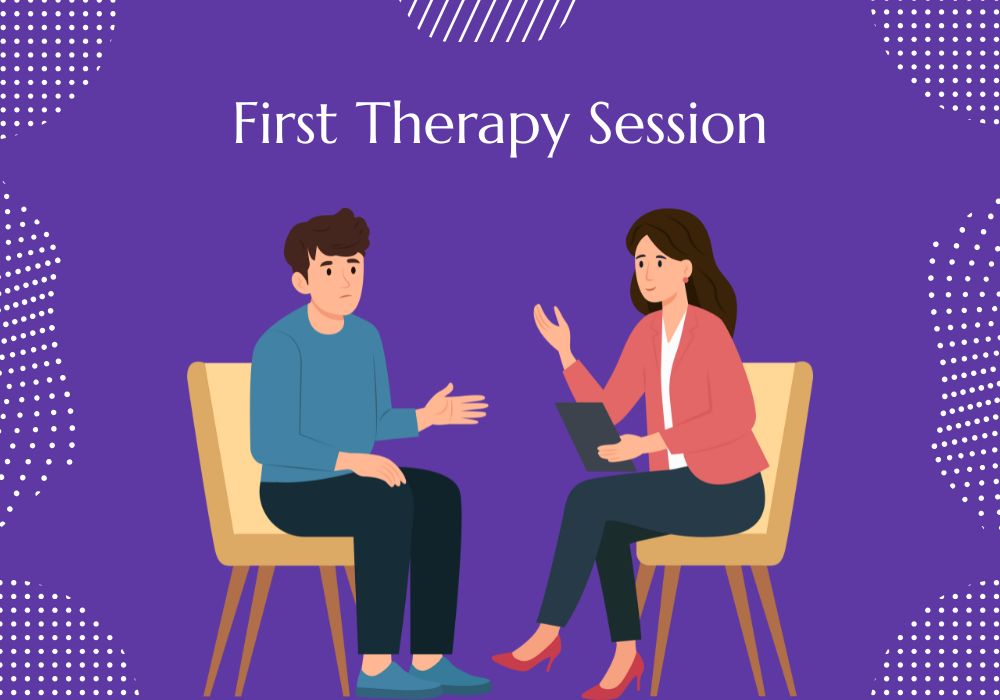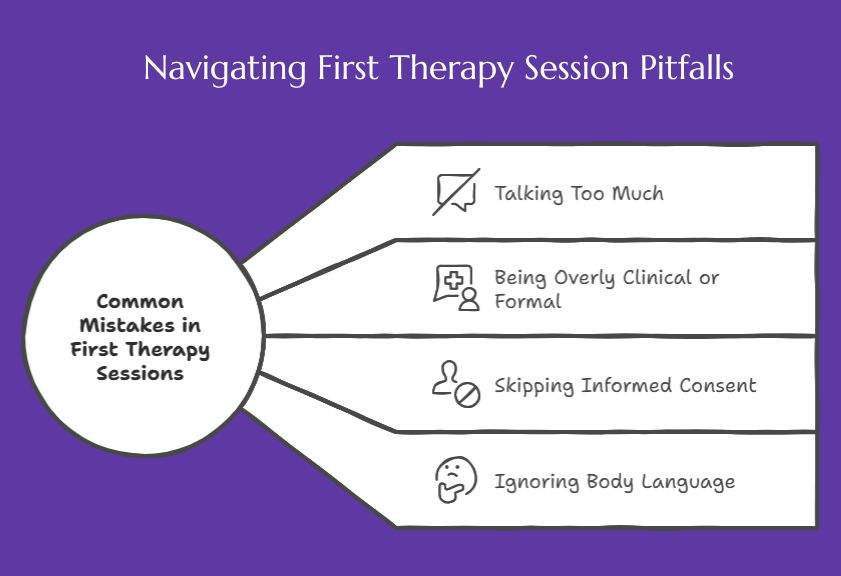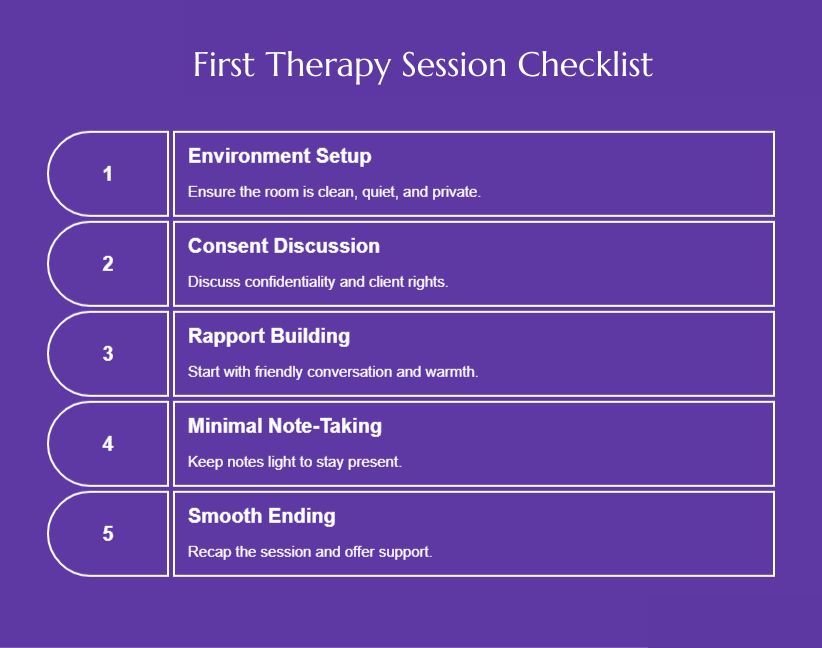The first therapy session is critical. It helps build trust between the therapist and client. Many new clients feel nervous or unsure. A good first session helps them feel safe and heard. Therapists should prepare well before this first meeting. They need to listen closely and create a calm space.
This allows clients to open up and share their thoughts and feelings. Instead of rushing to find answers, focus on making a strong connection. This guide gives easy tips to help you have a great first therapy session.
What Matters in the First Therapy Session
The first therapy session is not about solving all problems right away. What matters is building a good connection with your client. Therapists should focus on making clients feel safe and understood. This helps build trust and sets a strong base for future sessions.

Building Rapport, Not Rushing Diagnosis
Begin by getting to know your client without immediately jumping into diagnosis. Take time to listen and notice how they feel. A strong therapist-client relationship grows from trust, not from quick judgments.
Active Listening Over Structured Questioning
Instead of sticking only to strict questions, listen carefully to what your client shares. Please pay attention to their words and emotions. This helps you understand them better and makes the session feel natural.
Focus on Connection, Not Perfection
Don’t worry about making the session perfect. Focus on connecting with your client. Let them guide the conversation at their own pace. This creates a space where they feel comfortable and ready to open up.
How to Prepare Before the First Therapy Session
Preparing well in advance of the first therapy session helps you create a calm and welcoming space. This sets the right mood for the client and allows the session to go smoothly. Small steps in preparation can make a big difference in building trust and comfort.
Review Their Intake Form or Referral Notes
Start by reading the client’s intake form or referral notes. This provides you with the necessary background information about their situation. It helps you understand their needs and plan how to support them from the start.
Set Up a Comfortable, Safe Environment
Ensure your therapy room feels warm, inviting, and comfortable. Clear any clutter and arrange chairs so they face each other. Soft lighting and privacy help clients relax and open up more easily.
Clarify Your Intention for the Session
Before the client arrives, remind yourself of your goal. Focus on listening and building a connection. Having a clear intention helps you stay present and patient during the session.
What to Say (and Not Say) in the First Therapy Session
Knowing what to say in the first therapy session helps build trust and comfort. At the same time, avoiding specific topics or phrases keeps the conversation safe and open.
How to Start the Conversation Gently
- Begin with a warm greeting and a friendly tone.
- Use simple questions like, “How are you feeling today?”
- Let clients share at their own pace without pressure.
Phrases to Build Safety and Trust
- “This is a safe space to talk about anything.”
- “I’m here to listen and support you.”
- “You can share only what feels comfortable.”
Topics to Avoid in Session One
- Avoid diving into deep personal trauma right away.
- Don’t ask too many “why” questions early on.
- Skip judgmental or overly clinical language.
Making the Most of Your First Therapy Session
The first session is more than just a meeting, your chance to show clients they’re in the right place. Use this time to listen attentively, ask thoughtful questions, and give them the space to speak. These small steps help your client feel supported from the start.
Help Them Set Small, Clear Goals
Ask your client what they hope to get from therapy. Keep the focus on small, simple goals. For example, they might want to feel less anxious, sleep better, or improve relationships. Clear goals give both of you a direction to follow.
Use Open-Ended Questions
Instead of yes/no questions, try asking things like, “Can you tell me more about that?” or “What has this been like for you?” These open-ended questions help clients share more and feel understood.
Reflect What You Hear (Validation Tip)
Let your client know you’re truly listening. Use phrases like, “It sounds like that’s been really hard for you,” or “I hear that this has been stressful.” Reflecting their feelings helps them feel seen and supported.
Common First Session Mistakes Therapists Make
Even experienced therapists can slip up during a first session. Being aware of common mistakes helps you avoid them and create a more positive experience for your clients.

- Talking too much
- Let the client speak more than you. Don’t fill every silence.
- Focus on listening, rather than teaching or giving advice immediately.
- Let the client speak more than you. Don’t fill every silence.
- Being overly clinical or formal
- Avoid using too much technical language.
- Speak in a calm, human tone that feels warm and relatable.
- Avoid using too much technical language.
- Skipping informed consent or confidentiality explanation
- Always clearly explain to the client what they can expect in therapy.
- Ensure they understand their rights, including their right to privacy.
- Always clearly explain to the client what they can expect in therapy.
- Ignoring body language or emotional cues
- Pay attention to how the client is sitting, speaking, or reacting.
- If they seem nervous or withdrawn, slow down and check in gently.
- Pay attention to how the client is sitting, speaking, or reacting.
Questions to Ask in the First Therapy Session
Asking the right questions in the first session helps build trust and gives you insight into your client’s needs. Keep your tone gentle and curious. Ask simple, open-ended questions that invite honest answers without putting pressure on the respondent.
“What brings you here today?” (with empathy)
This question helps you understand the client’s primary anxiety. Ask it with care, and let them explain in their own words. Don’t rush them. A simple, “What’s been going on for you lately?” also works well.
“What does a good session feel like for you?”
This question helps you understand what they need from therapy. Some clients may want to feel heard. Others may want to work on tools and solutions. Knowing this enables you to adjust your style to support them better.
“Have you been to therapy before? What worked or didn’t?”
This gives you a helpful background. It tells you what has helped in the past and what hasn’t. It also shows that you care about what works best for them. Listen closely and take mental notes.
How to End the First Therapy Session Positively
Ending the first session on a positive note helps your client feel safe, supported, and ready to return. A calm and thoughtful wrap-up builds trust and sets the stage for next time.
- Recap key points
- Briefly go over what the client shared.
- Highlight moments that stood out or felt important.
- Use simple phrases like, “So today we talked about…”
- Briefly go over what the client shared.
- Offer reassurance
- Remind them that it’s okay to take things slowly.
- Say something like, “You did great today,” or “It’s a good start.”
- Remind them that it’s okay to take things slowly.
- Set expectations for the next session.
- Let them know what to expect moving forward.
- Mention possible topics, tools, or plans gently.
- Let them know what to expect moving forward.
- Offer a choice for scheduling and follow-up.
- Ask what feels best for their next session time.
- Offer flexible options to build comfort and trust.
- Ask what feels best for their next session time.
Have more questions about therapy? We’re here to help. Contact us today for guidance, support, and answers tailored to your unique needs and concerns.
First Therapy Session Checklist for Therapists

A simple checklist can help you stay focused and calm during your first session with a new client. Use this as a quick reminder to cover the basics while keeping the session warm and personal.
- Environment
- The room is clean, quiet, and private.
- Seating is comfortable and welcoming.
- No clutter or distractions
- The room is clean, quiet, and private.
- Consent discussed
- Go over confidentiality and session structure.
- Make sure the client understands their rights.
- Ask if they have any questions.
- Go over confidentiality and session structure.
- Rapport started
- Begin with a small, friendly conversation.
- Show warmth through body language and tone.
- Focus on connection, not perfection.
- Begin with a small, friendly conversation.
- Notes minimal
- Keep note-taking light so you stay present.
- Make eye contact and stay engaged.
- Jot down only key points for later.
- Keep note-taking light so you stay present.
- Ending smooth
- Recap what was shared.
- Offer support and hope.
- Set a clear, calm path for the next session.
- Recap what was shared.
Conclusion
The first therapy session isn’t about solving everything. It’s about creating a safe and calm start. Focus on listening, building trust, and helping your client feel heard. You don’t need to be perfect, just present.
Every client is different. Go at their pace, not yours. Keep the session simple, relaxed, and supportive. That’s what helps people come back.
When you prepare well and stay focused, you make a difference. And that first step? Stay tuned to The Healing Journey to get started.
Frequently Asked Questions
What should I focus on during the first therapy session?
Focus on building trust and connection. Listen more than you talk. Don’t rush into diagnosis; help the client feel safe and heard.
How do I handle a client who is silent or nervous?
Be patient. Use warm, gentle questions. Allow silence without pressure. Show calm body language and remind them it’s okay to take their time.
Should I set goals in the first session?
Yes, but keep them small and clear. Ask what they hope to gain from therapy. This helps guide future sessions without feeling overwhelmed.
Do I need to explain consent and confidentiality in the first session?
Absolutely. Always explain how sessions work, what’s private, and when information must be shared. This builds trust from the beginning.
How do I end the first session smoothly?
Recap what was shared, thank the client for their openness, and gently set a plan for next time. Keep the tone calm and supportive.

One Response